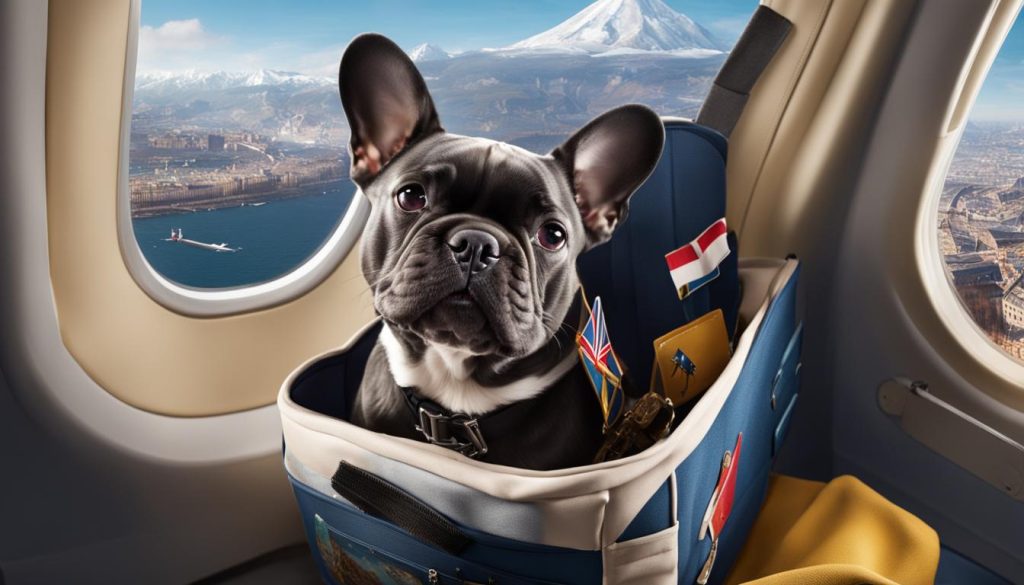Traveling with pets can be complex, especially when it comes to understanding the pet policies of major airlines. In this comprehensive guide, I will navigate you through the maze of pet policies for various airlines, ensuring that your furry friend can travel with you stress-free. From in-cabin pet policies to pet carrier size restrictions and airline pet fees, we will cover all the important details you need to know.
Key Takeaways:
- Major airlines have different pet policies that pet owners need to be aware of.
- In-cabin pet policies vary in terms of pet carrier size restrictions and additional fees.
- Large dogs may have limited options for flying in-cabin and are often transported as cargo or checked baggage.
- When traveling with a dog in Europe, there are specific paperwork requirements to fulfill.
- Transportation options for dogs within Europe include trains, flights, and ferries, each with their own rules and regulations.
Flying With a Large Dog in Cabin: Is it Possible?
When it comes to flying with pets, many major airlines have restrictions on the size of dogs that are allowed in the cabin. While most commercial airlines require large dogs to be checked as baggage or transported in cargo, there are some options available for flying with a large dog in the cabin.
Private and semi-private airlines like JSX, Aero, Tradewind Aviation, Surf Air, and BLADE allow large dogs in the cabin, with various restrictions and additional fees. Linear Air and EVOJets offer private charter options for flying with large dogs. each airline may have specific weight limits and requirements for traveling with a large dog in the cabin.
Flying With a Large Dog in Cabin: Is it Possible?
| Airline | Restrictions | Additional Fees |
|---|---|---|
| JSX | Large dogs allowed in cabin with a size restriction | Varies depending on destination |
| Aero | Large dogs allowed in cabin with a size restriction | Additional fee applies |
| Tradewind Aviation | Large dogs allowed in cabin with a size restriction | Additional fee applies |
| Surf Air | Large dogs allowed in cabin with a size restriction | Additional fee applies |
| BLADE | Large dogs allowed in cabin with a size restriction | Additional fee applies |
| Linear Air | Private charter options available for large dogs | Varies depending on destination |
| EVOJets | Private charter options available for large dogs | Varies depending on destination |
While it may require some additional research and planning, flying with a large dog in the cabin is possible with select airlines. Make sure to check the specific policies and requirements of each airline before booking your flight to ensure a smooth and hassle-free journey for both you and your four-legged friend.

Airlines that Allow Large Dogs as Cargo/Checked
When it comes to pet travel, not all airlines have the same policies and regulations for accommodating large dogs. If your furry friend is too big to fit in the cabin, there are several major airlines that allow dogs to be transported as cargo or checked baggage. These airlines understand the importance of ensuring your pet’s safety and comfort during the journey.
Here are some of the airlines that allow large dogs as cargo or checked baggage:
- Air Canada
- Air France
- American Airlines
- Delta Airlines
- Emirates
- Hawaiian Airlines
- Lufthansa
- Swiss International Airlines
- WestJet
Each airline has its own set of rules and regulations regarding pet travel. I recommend that you check with the specific airline for their policies and procedures, including weight limits, crate requirements, and additional fees. This will ensure that you are well-prepared and can make necessary arrangements for your dog’s travel.
| Airline | Weight Limit | Crates/Cage Requirements | Additional Fees |
|---|---|---|---|
| Air Canada | Maximum 100 kg (including crate) | Varies based on aircraft type | Varies based on destination and weight |
| Air France | Varies based on aircraft type | Specific crate requirements | Varies based on destination |
| American Airlines | Varies based on aircraft type | IATA-compliant crate required | Varies based on weight and destination |
| Delta Airlines | Maximum 60 inches in length and 230 pounds (including crate) | IATA-compliant crate required | Varies based on destination and weight |
| Emirates | Varies based on aircraft type | Specific crate requirements | Varies based on destination |
| Hawaiian Airlines | Maximum 70 pounds (including crate) | IATA-compliant crate required | $60-$225 per direction |
| Lufthansa | Varies based on aircraft type | Specific crate requirements | Varies based on destination |
| Swiss International Airlines | Varies based on aircraft type | Specific crate requirements | Varies based on destination |
| WestJet | Maximum 45 kg (including crate) | Specific crate requirements | $100-$250 per direction |
Traveling with a large dog can be made easier with the right airline that caters to your pet’s needs. By choosing an airline that allows large dogs as cargo or checked baggage, you can ensure that your furry friend can travel safely and comfortably to your destination.
Pet Travel in Europe: A Guide for Dog Owners
When it comes to pet travel, Europe is a destination that welcomes furry friends with open arms. Whether you’re planning a city break in Paris, exploring the picturesque landscapes of Italy, or embarking on an adventure in the Swiss Alps, bringing your dog along can enhance your travel experience. However, before jetting off to Europe with your canine companion, be aware of the logistics and requirements involved in traveling with a dog.
First and foremost, I would advise that you familiarize yourself with the necessary paperwork for traveling to Europe with a dog. Depending on the country you are traveling to, your dog may need to be microchipped, vaccinated for rabies, have an EU health certificate, and potentially undergo a rabies titre test or worming treatment. These requirements may vary for EU countries, non-EU countries, and countries like the UK with their own pet travel regulations. Ensuring that you have all the necessary paperwork in order before your trip will save you from any unnecessary hassle or delays.
Once you’re in Europe, traveling between countries with your dog becomes relatively easier, especially within the European Union (EU). In most EU countries, dogs can move freely without additional paperwork. However, carry copies of your dog’s EU animal health certificate or EU pet passport, depending on your destination. Some non-EU countries may have specific requirements, such as rabies titre tests or quarantines. Understanding the paperwork needed for traveling between European countries will ensure a smooth journey for you and your dog.
Table: European Countries and Their Pet Travel Requirements
| Country | Microchipping | Rabies Vaccination | EU Health Certificate | Rabies Titre Test | Additional Requirements |
|---|---|---|---|---|---|
| France | Required | Required | Required | Not required | None |
| Italy | Required | Required | Required | Not required | None |
| Germany | Required | Required | Required | Not required | None |
| United Kingdom | Required | Required | Required | Required | 14-day quarantine |
local transport options in Europe can vary from city to city and country to country. While some cities are more dog-friendly, others may have specific rules and restrictions. Researching the local transport regulations regarding dogs, such as buses and trains, will help you plan your day-to-day activities and explore Europe with ease. Additionally, dog-friendly accommodations and activities are plentiful in Europe, with many hotels, restaurants, and parks catering to canine companions.
Travelling with a dog in Europe can be a memorable experience, allowing you to create lasting memories with your furry friend. By understanding the necessary paperwork, the ease of movement within the EU, and the local transport options, you can embark on a pet-friendly adventure across the diverse landscapes and cultures of Europe.

Paperwork for Travelling to Europe with a Dog
When planning to travel to Europe with your dog, there are several important paperwork requirements that you need to be aware of. These requirements may vary depending on the country you are traveling to, so I would advise that you research and prepare well in advance. Here are some key documents that you may need:
- Microchip: Your dog must have a microchip implanted, which provides a unique identification number. This is usually a prerequisite for all other paperwork.
- Rabies Vaccination: Your dog must be vaccinated against rabies. The vaccination should be administered at least 21 days before your travel date.
- EU Health Certificate: If you are traveling from a non-EU country to an EU country, or within the EU, your dog will need an EU Health Certificate. This certificate confirms that your dog is healthy and meets the EU’s entry requirements.
- Rabies Titre Test: Depending on the country you are traveling to, a rabies titre test may be required. This blood test measures the level of rabies antibodies in your dog’s bloodstream and ensures that your dog has sufficient immunity against rabies.
- Additional Requirements: Some countries may have additional requirements, such as specific vaccines or treatments for certain diseases.
these requirements may differ for EU and non-EU countries. For example, if you are traveling to the UK, you will need to follow the specific pet travel regulations set by the UK government.
Before traveling, make sure to consult with your veterinarian and the embassy or consulate of the country you are visiting to ensure that you have all the necessary paperwork in order. Failing to comply with these requirements may result in your dog being denied entry or subjected to quarantine upon arrival.
Table: Required Pet Travel Documents for Europe
| Document | Description |
|---|---|
| Microchip | A small electronic device implanted in your dog that provides a unique identification number. |
| Rabies Vaccination | A vaccination against rabies, administered at least 21 days before travel. |
| EU Health Certificate | A certificate confirming that your dog is healthy and meets the EU’s entry requirements. |
| Rabies Titre Test | A blood test to measure the level of rabies antibodies in your dog’s bloodstream. |
| Additional Requirements | Some countries may have additional requirements, such as specific vaccines or treatments for certain diseases. |
I recommend that you thoroughly research and understand the paperwork requirements for traveling with a dog to Europe. By ensuring that you have all the necessary documents, you can ensure a smooth and hassle-free journey for both you and your furry friend.

Traveling Between European Countries with a Dog
When traveling with your dog between European countries, understand the requirements and documentation needed to ensure a smooth journey. As a pet owner, you’ll be pleased to know that traveling with your furry friend within Europe is generally hassle-free, especially within the European Union (EU). However, there are still a few important things to keep in mind.
“Traveling with my dog within Europe was a breeze thanks to the EU pet passport. It made crossing borders and exploring different countries so much easier. I highly recommend getting one for your four-legged companion!”
– Pet owner testimonial
The EU pet passport is a standardized document that allows for easy travel within the EU. It includes your dog’s vaccination records, microchip information, and other essential details. Having this passport will ensure that you meet the pet travel requirements and regulations of each country you visit.
It’s noteworthy that some non-EU countries may have additional requirements for traveling with dogs. For example, certain countries may require a rabies titre test or impose quarantine periods. I highly suggest that you research and familiarize yourself with the specific regulations of the countries you plan to visit to avoid any unexpected surprises.
While traveling between European countries with a dog is generally straightforward, always remember to prioritize your dog’s comfort and well-being. Ensure that your dog is comfortable during transportation and has access to water, food, and regular bathroom breaks. By following the necessary paperwork and taking care of your dog’s needs, you can enjoy a memorable journey exploring the diversity and beauty of Europe with your loyal companion.

Table: EU Pet Passport Requirement for Traveling Between European Countries
| Country | EU Pet Passport Required |
|————————-|————————–|
| Austria | Yes |
| Belgium | Yes |
| Bulgaria | Yes |
| Croatia | Yes |
| Cyprus | Yes |
| Czech Republic | Yes |
| Denmark | Yes |
| Estonia | Yes |
| Finland | Yes |
| France | Yes |
| Germany | Yes |
| Greece | Yes |
| Hungary | Yes |
| Ireland | Yes |
| Italy | Yes |
| Latvia | Yes |
| Lithuania | Yes |
| Luxembourg | Yes |
| Malta | Yes |
| Netherlands | Yes |
| Poland | Yes |
| Portugal | Yes |
| Romania | Yes |
| Slovakia | Yes |
| Slovenia | Yes |
| Spain | Yes |
| Sweden | Yes |
| United Kingdom | No |
| Norway | No |
| Switzerland | No |
| Iceland | No |
| Liechtenstein | No |
| Andorra | No |
| Monaco | No |
| San Marino | No |
| Vatican City | No |
| Serbia | No |
| Montenegro | No |
| Bosnia and Herzegovina | No |
| Albania | No |
| North Macedonia | No |
| Kosovo | No |
| Belarus | No |
| Moldova | No |
| Ukraine | No |
| Russia | No |
Long-Distance Transport in Europe with a Dog
When traveling long distances within Europe, there are various options available for transporting your dog. Train travel is a popular choice, as most European train companies allow dogs on board. However, some countries may have specific rules and regulations for traveling with dogs. In some cases, larger dogs may need to be muzzled or kept in a carrier. It’s best to research the specific train company and their guidelines before embarking on your journey.

Flying with a dog is another option for long-distance travel in Europe. Many airlines have pet travel programs that allow dogs to be transported in the cargo hold. However, please check the specific requirements and restrictions of each airline before booking your flight. Some airlines may have breed restrictions or require certain documentation, such as health certificates or vaccination records.
Another means of long-distance transport in Europe is by ferry. This is particularly useful when traveling between the UK and continental Europe or within Greece. Ferry companies such as Stena Line, P&O Ferries, and Blue Star Ferries often allow dogs on board for an additional fee. It’s advisable to contact the ferry company in advance to confirm their pet policies and any requirements they may have.
Train Travel with a Dog
Train travel is generally a dog-friendly option for long-distance transport in Europe. Many European train companies allow dogs on board, though there may be certain restrictions and guidelines to follow. Here are some popular train companies that accommodate dogs:
| Train Company | Country | Pet Policy |
|---|---|---|
| SNCF | France | Dogs allowed in carriers for free |
| Deutsche Bahn | Germany | Dogs allowed on board for a small fee |
| Trenitalia | Italy | Dogs allowed in carriers for free |
I recommend that you check the specific guidelines of each train company, as rules may vary. Some train companies may require dogs to be muzzled or kept in carriers, while others may have size restrictions. Additionally, it’s advisable to book your ticket in advance and inform the train company that you will be traveling with a dog to ensure availability and proper arrangements.
Local Transport in Europe with a Dog
When traveling with your dog in Europe, navigating local transportation can vary depending on the city and country you are in. Some cities are more dog-friendly than others, allowing dogs on public transportation such as buses and trains. However, familiarize yourself with the local transport rules and regulations regarding dogs, as well as any additional fees or restrictions that may apply.
In cities where dogs are permitted on public transportation, they may need to be in a carrier or muzzled for the safety and comfort of other passengers. It’s always a good idea to check with the local transport authorities or visit their website to ensure you have the most up-to-date information on traveling with your dog.
While some cities may have restrictions or requirements for dogs on public transportation, there are often alternative options available. For example, many European cities are pedestrian-friendly, making it easy to explore on foot with your dog. Additionally, hiring a taxi or using ride-sharing services can be a convenient way to get around with your four-legged companion.
When planning your dog-friendly adventures in Europe, be sure to research the specific local transport options available in each city you plan to visit. This will help you make the necessary arrangements and ensure a smooth and enjoyable experience for both you and your furry friend.

| City | Public Transportation | Additional Notes |
|---|---|---|
| Amsterdam | Buses, trams, and trains | Dogs must be leashed and muzzled. |
| London | Tubes, buses, and trains | Dogs must be leashed and muzzled on public transportation. |
| Paris | Metro, buses, and trains | Dogs must be leashed and muzzled on public transportation. |
| Berlin | Tram, buses, and trains | Dogs are generally allowed on public transportation, but restrictions may apply during peak hours. |
| Rome | Buses, trams, and trains | Dogs must be leashed and muzzled on public transportation. |
Final Thoughts:
Understanding the local transport options and regulations for traveling with your dog in Europe is essential for a smooth and enjoyable trip. While some cities may have restrictions or requirements for dogs on public transportation, there are often alternative options available, such as walking or using taxis. By researching and planning ahead, you can ensure a dog-friendly travel experience in Europe.
Final Thoughts
Traveling with pets, especially dogs, can be a rewarding experience with proper planning and understanding of airline pet policies and travel requirements. Whether you are flying with a large dog in the cabin or transporting your dog as cargo, following the guidelines and regulations set by each airline is crucial to ensure a safe and stress-free journey.
Additionally, when traveling in Europe with a dog, being aware of the paperwork, local transport options, and dog-friendly accommodations and activities will enhance your overall travel experience. Try to always prioritize your pet’s comfort and well-being during the journey.
So, whether you’re jetting off on a domestic flight or embarking on an international adventure, rest assured that with the right information and preparation, you and your furry friend can enjoy a fantastic travel experience together. Safe travels!
FAQ
What are the pet policies of major airlines?
Each major airline has its own pet policy, including regulations on pet size, carrier requirements, and fees. I recommend that you check with the specific airline for their policies and procedures when traveling with a pet.
Can I fly with a large dog in the cabin?
Private and semi-private airlines like JSX, Aero, Tradewind Aviation, Surf Air, and BLADE allow large dogs in the cabin, with restrictions and additional fees. Linear Air and EVOJets offer private charter options for flying with large dogs. Most commercial airlines require large dogs to be checked as baggage or transported in cargo.
How can I transport my large dog when flying internationally?
Airlines like Air Canada, Air France, American Airlines, Delta Airlines, Emirates, Hawaiian Airlines, Lufthansa, Swiss International Airlines, and WestJet allow dogs to be transported as cargo or checked baggage for international travel. Each airline has its own rules and regulations regarding pet travel.
What paperwork is required to bring a dog to Europe?
Depending on the country you are traveling to, your dog may need to be microchipped, vaccinated for rabies, have an EU health certificate, and potentially undergo a rabies titre test or worming treatment. You should also have all the necessary paperwork in order before traveling with your dog to Europe.
What paperwork is required to travel between European countries with a dog?
Within the European Union (EU), most EU countries allow dogs to move freely without additional paperwork. However, carry copies of your dog’s EU animal health certificate or EU pet passport, depending on your destination. Non-EU countries may have specific requirements, such as rabies titre tests or quarantines.
What are the options for long-distance transport with a dog in Europe?
Train travel is generally dog-friendly in Europe, with most European train companies allowing dogs on board. Flying with a dog is also an option, but restrictions may apply, especially when traveling to the UK. Ferries can be used for transport between the UK and continental Europe or within Greece.
What are the local transport options for getting around in Europe with a dog?
Local transport rules and regulations regarding dogs vary from city to city and country to country in Europe. Some cities allow dogs on public transportation, such as buses and trains, with specific rules for large dogs or carrier requirements. I recommend that you research the local transport rules and any additional fees or restrictions that may apply.
How can I ensure a safe and stress-free journey when traveling with a pet?
To ensure a safe and stress-free journey when traveling with a pet, follow the guidelines and regulations set by each airline. This includes understanding pet policies, adhering to pet carrier size restrictions, and being aware of any additional fees. Prioritizing your pet’s comfort and well-being is essential throughout the journey.






